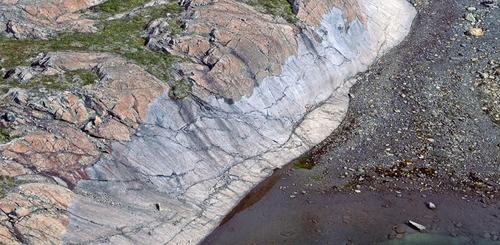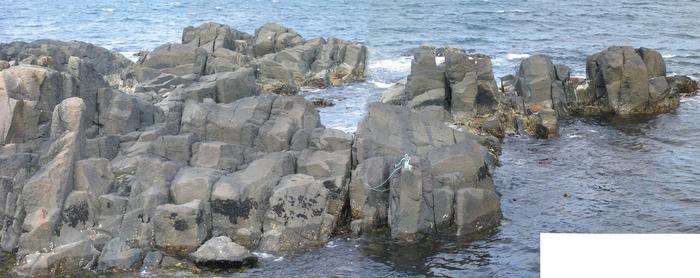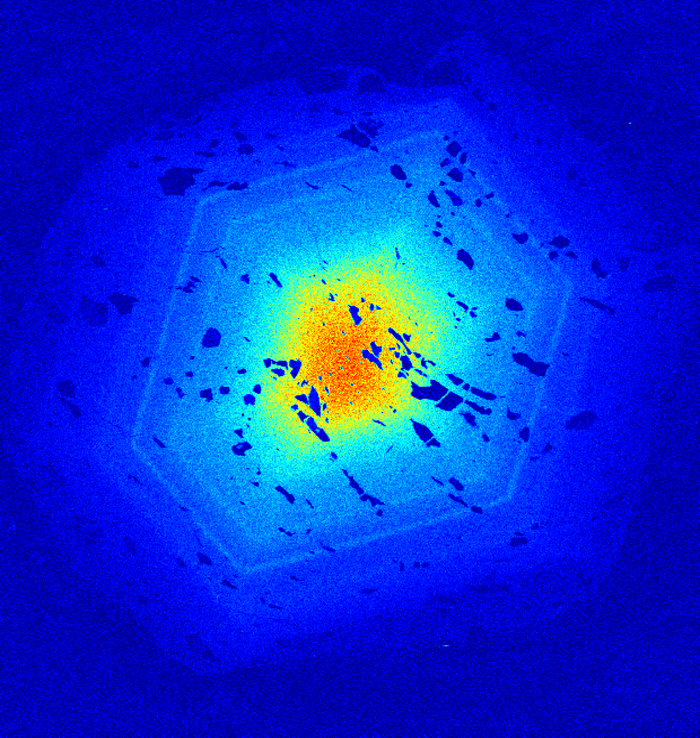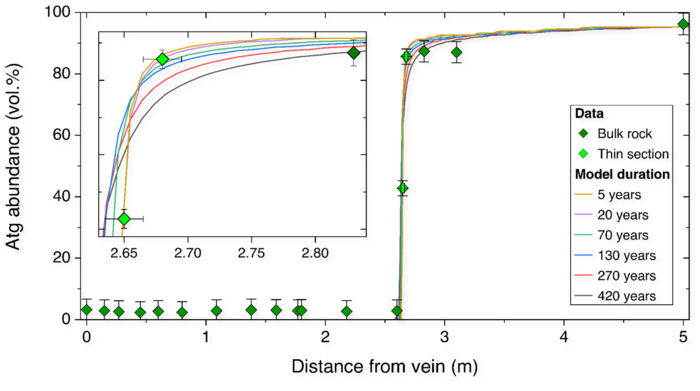Time scales of metamorphic and metasomatic processes
Exhumed rocks can provide insight into global geodynamic and plate tectonic processes. Their geological history is often preserved within the mineralogic and isotopic record, which can be used as a tracer for the P-T evolution and rates and timescales of subduction, exhumation, hydration or dehydration processes that take place during orogenesis.
Duration of fluid-rock interaction
To understand the global volatile cycle and the evolution of Earth’s mantle-crust-atmosphere system, the investigation of fluid cycles in the Earth’s interior are of great interest. Unfortunately, the timescales of these regional fluid–rock interactions remain unconstrained in large parts. Applying chronometers to examine the duration of fast geologic processes, such as fluid-rock interactions, is a challenging task because commonly used isotopic chronometers are too imprecise to resolve such short-lived events, which last only several thousands of years or less. Therefore, we use fast diffusing elements, such as lithium, to determine the relative timescales of diffusive processes during fluid-rock interaction.
The durations of fluid-rock interaction are studied in wall rock – vein systems, where the formation of alteration zones between the pristine wall rock and the vein (fluid) in either cm- or outcrop-scale can be observed. By sampling continuous profiles along such alteration zones provides insight into the progressive alteration from the fluid contact into the wall rock. These profiles are analyzed by using mineralogical and petrological analytical techniques (e.g. EMP, SEM, LA-ICP MS) combined with geochemical bulk rock (isotope) analysis (ion-exchange chromatography, MC-ICP MS).
This data will allow us not only to determine how much time was needed to develop this alteration zone, but also to reveal how the fluids migrate through the host rock and trigger mineral reactions, which effectively controls the petrophysical properties of the deep continental crust.
Further reading: John et al. (2012); Taetz et al. (2018)
Constraining exhumation rates from diffusion modelling
An ideal mineral to investigate the P-T-t (pressure-temperature-time) history of metamorphic rocks is garnet. Garnet is a major mineral phase in many metamorphic rocks. It commonly preserves distinct chemical zoning that is produced during its growth and that can be used to constrain the metamorphic and metasomatic evolution of the rock.
In this project we combine petrography, thermodynamic modelling, and diffusion modelling of distinct chemical zoning in garnet to determine timescales of exhumation of blueschist-facies rocks. In particular, the P-T path of a rock can be constrained by thermodynamic modelling of phase diagram sections, by performing Raman spectroscopy on quartz-in-garnet inclusions and on carbonaceous matter, or by applying conventional geothermobarometry. Effectively, well-constrained P-T paths combined with diffusion modelling that can provide durations of metamorphic processes allow us to infer timescales of e.g., exhumation processes. Our most recent results suggest that within subduction settings exhumation may proceed on the order of up to 40-45 cm/year, at least at relatively large depths. This may provide us with a new understanding on how exhumation may proceed along the plate interface of subduction zones.
Figure caption: Osczillatory zonation of Mn in a garnet grain from the Tianshan high-pressure metamorphic belt in China. Click on the image for a larger view!
Further reading: Schwarzenbach et al. (2021)
Chronometry via reactive-transport modelling
Another tool to understand time scales of metamorphic processes is the simulation of mineral reactions and reaction fronts by using numerical models. To this end we develop numerical models that obey the mass, momentum, and energy conservation laws in combination with local thermodynamic equilibrium. The resulting computer models allow simulation of propagation of reaction fronts. Using the latest thermodynamic models of minerals and fluids, the simulations can be fitted to observations to retrieve the duration of fluid-rock interaction. We applied this method in a study on the carbonation of serpentinite in which the soapstone reaction front was simulated and matched to the detailed mineral modes and chemistry observed in the field and in the lab. We found that it must have taken only 5-20 years to generate a 3-meter soapstone front. This geologically instantaneous reaction changes our view of metamorphic processes which are traditionally thought to be occurring on geological time scales. However, it agrees with other studies that also concluded that metamorphic processes happen faster than traditionally thought (Ague & Baxter, 2007, John et al,. 2012; Taetz et al., 2018).
Figure caption: Profile in 1D across a soapstone reaction front monitored by the abundance of serpentine (atg) on the y-axis. The lines show several model simulations fitted to natural observations. The best fit is obtained from the simulation of 5 or 20 years. Click on the image for a larger view!
Further reading: Beinlich et al. (2020)



